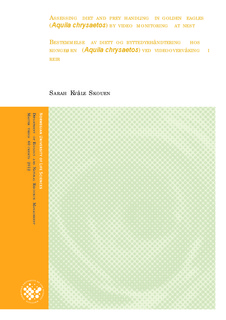| dc.description.abstract | The diet and handling of prey in breeding golden eagles (Aquila chrysaetos) was studied by video monitoring one nest in southern Norway in a year of peak vole (Cricetidae) population and low willow grouse (Lagopus lagopus) population, from the nestlings were c. 10 days old until fledging. Handling time was determined for different prey types and prey sizes when the female fed the nestlings and when the nestlings fed unassisted. A total of 181 prey items were recorded delivered. In total 70% of all prey items delivered at the nest were birds and 30% were mammals. The most important prey type was willow grouse, both by numbers (34%) and by mass (35%). Mountain hare (Lepus timidus) and red fox (Vulpes vulpes) made up 7% and 3%, respectively, by numbers, and 33% and 14%, respectively, by mass. Thrushes (Turdus sp.) (24%), Microtus voles (11%) and lemming (Lemmus lemmus) (9%) were also important numerically as prey in the breeding diet of the eagles. No ungulates were observed delivered at the nest. The male golden eagle delivered the majority of prey (68%) to the nest and he mainly delivered birds (80%). The probability of delivering a willow grouse at the nest decreased throughout the season. The eagles appeared to adjust hunting strategy to prey species, and willow grouse was most likely hunted by using a win-shift strategy while thrushes were more likely to be hunted with a win-stay strategy. Preparation of prey prior to delivery at the nest (plucking or partitioning) was more likely for avian than for mammalian prey, and also for larger prey, but less likely with increasing age of the nestlings. Further preparation in the nest by plucking of prey before feeding was more likely to be preformed by the female rather than by the nestlings. Handling time was longer for mammalian than for avian prey and increased with body mass of the prey, both when the female fed the nestlings and when the nestlings ingested prey unassisted. To explain prey selection there is still a need for assessing handling efficiency of different prey. | no_NO |
